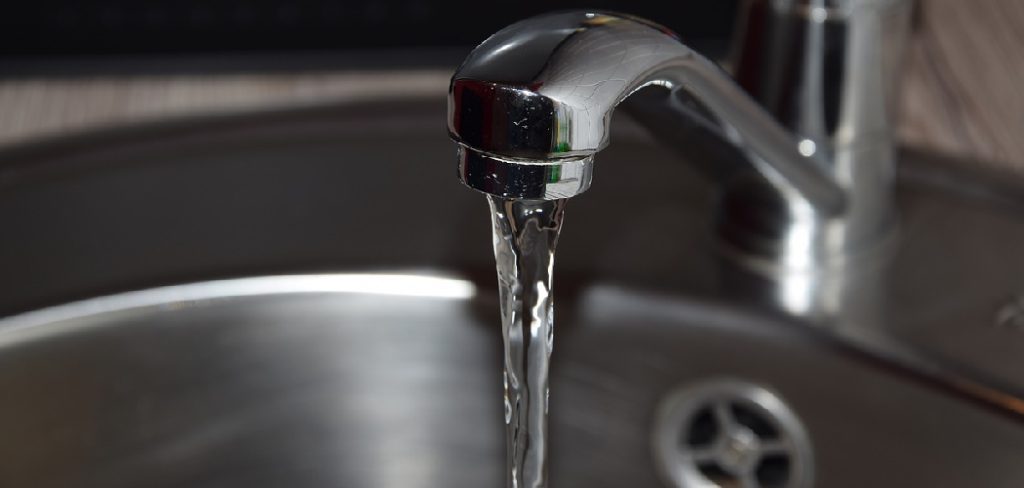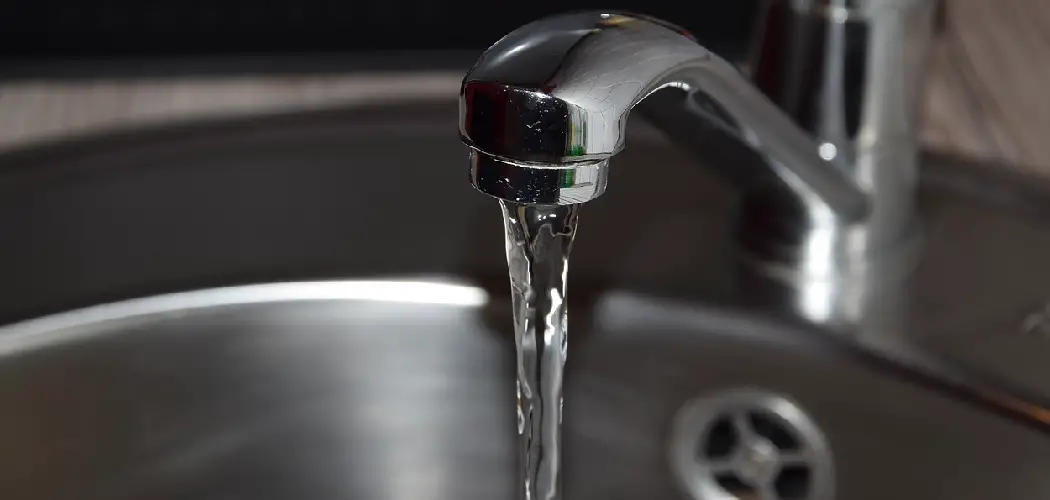Are you fed up with your faucet head being filthy and unsightly? Do you want to find a way to keep it looking clean without having to use vinegar every time? Well, don’t despair any longer! There are actually many ways that you can easily and quickly clean your faucet head without resorting to using vinegar.
In this blog post, we’ll take a look at some of the best methods for getting rid of tough dirt and grime on your kitchen or bathroom sink taps. Keep reading if you’re interested in finding out how to clean faucet head without vinegar.

Benefits of Cleaning Faucet Head Without Vinegar
Cleaning your faucet head without vinegar offers several benefits:
1. Avoiding Strong Odors
Vinegar has a strong smell that some people find unpleasant. By choosing alternative cleaning methods, you can eliminate the vinegar odor and create a more pleasant cleaning experience.
2. Safer for Certain Materials
Vinegar is acidic and can potentially damage certain materials, such as brass or nickel finishes. By using vinegar-free cleaning solutions, you can protect the integrity and appearance of your faucet head.
3. Environmentally Friendly
Many vinegar-free cleaning alternatives utilize natural ingredients, such as lemon juice or baking soda, which are eco-friendly and biodegradable. Opting for these alternatives can reduce your reliance on harsh chemicals and minimize your environmental impact.
4. Versatility
While vinegar is a versatile cleaning agent, it may not suit all cleaning tasks. By exploring vinegar-free options, you can discover a wider range of effective cleaning methods for different types of stains and mineral deposits.
5. Gentle Cleaning
Some individuals prefer milder, gentle cleaning solutions on their skin and surfaces. Vinegar-free alternatives, such as lemon juice or toothpaste, offer a more gentle approach to cleaning faucet heads while still effectively removing dirt, grime, and mineral buildup.
6. Wide Availability
Unlike vinegar, which may not always be readily available or convenient to use, vinegar-free cleaning ingredients like lemon juice or baking soda can be found in most households. This makes it easier to clean your faucet head without having to make a special trip to the store.
7. Cost-Effective
Vinegar-free cleaning solutions are often inexpensive and can be a cost-effective alternative to commercial cleaning products. Using common household items like lemon juice or baking soda can save you money while achieving excellent cleaning results.
Incorporating these benefits into your blog post will help readers understand why cleaning their faucet head without vinegar can be a practical and advantageous choice.
8 Methods on How to Clean Faucet Head Without Vinegar
Method 1: Lemon Juice
Lemon juice has natural acidic properties that make it a great alternative to vinegar for cleaning faucet heads. Squeeze half a lemon into a bowl and mix with equal parts water. Soak a cloth in the mixture and use it to wipe down your faucet head, paying special attention to areas with stubborn dirt or grime buildup. Rinse the cloth off with clean water and use it to remove any remaining residue.
Method 2: Baking Soda
Baking soda is another natural cleaning agent used to clean a faucet head without vinegar. Make a paste by mixing baking soda and water in a bowl. Apply the paste to your faucet head and let it sit for a few minutes before using a damp cloth to wipe away the residue.
Method 3: Toothpaste
Toothpaste is another great alternative for cleaning a faucet head without vinegar. Apply some toothpaste to a damp cloth and use it to scrub away any dirt or grime buildup. Rinse the cloth with clean water and wipe away any remaining residue before using it again.
Method 4: Dish Soap
Dish soap is a mild yet effective cleaning agent that can remove dirt and grime from a faucet head without vinegar. Simply wet the faucet head and apply a small amount of dish soap. Gently scrub the surface with a soft cloth or brush before rinsing with clean water.
Method 5: Rubbing Alcohol
Rubbing alcohol is another excellent option for cleaning a faucet head without vinegar. Simply pour some rubbing alcohol onto a damp cloth and use it to scrub away any dirt or grime buildup. For tougher stains, you may need to let the alcohol sit for a few minutes before wiping it off with a clean cloth.
Method 6: Hydrogen Peroxide
Hydrogen peroxide is another powerful cleaning agent that can be used in place of vinegar. Simply apply some hydrogen peroxide to a damp cloth and use it to scrub away any dirt or grime buildup. Rinse the cloth with clean water and remove any remaining residue before using it again.
Method 7: White Vinegar
White vinegar is an effective cleaning agent that can be used in place of regular vinegar for cleaning faucet heads. Simply fill a spray bottle with white vinegar and spray it onto the faucet head. Use a cloth or brush to scrub away any dirt or grime buildup before rinsing off with clean water.
Method 8: Bar Keepers Friend
Bar Keepers Friend is a powerful cleaning agent that can be used in place of vinegar. Simply wet the faucet head and sprinkle some Bar Keepers Friend onto it. Gently scrub the surface with a soft cloth or brush before rinsing off with clean water.
4 Common Mistakes People Might Make When Cleaning Faucet Head Without Vinegar
1. Using Too Much Pressure
When scrubbing a faucet head without vinegar, it is important to use light strokes and not apply too much pressure. Scrubbing too hard or using abrasive materials may damage the surface of your faucet head, so be sure to use gentle motions when cleaning.
2. Choosing the Wrong Cleaner
When cleaning a faucet head without vinegar, it is important to choose the right cleaner. Make sure to select a cleaner that is compatible with the material of your faucet head and not too abrasive. This will help ensure that you are using the most effective and safe cleaning method.
4. Not Rinsing the Faucet Head
After cleaning a faucet head without vinegar, it is important to rinse off any residual cleaner with clean water. This will help ensure that no chemicals or cleaning agents are left behind, which could potentially damage the surface of your faucet head. Be sure to give your faucet head a thorough rinsing before replacing it.
These are a few common mistakes people might make when cleaning faucet heads without vinegar. Incorporating this information into your blog post can help readers avoid these potential pitfalls and ensure that they are using the most effective and safe cleaning methods.
Safety Tips
Safety should always be a priority when cleaning any household item, including your faucet head. Here are some important safety tips to keep in mind:
1. Protective Gear
Consider wearing protective gloves while cleaning your faucet head to protect your skin from any potentially harsh cleaning agents or abrasive materials.
2. Ventilation
Ensure that the area where you’re cleaning your faucet head is well-ventilated. Open windows or turn on exhaust fans to allow fresh air to circulate and prevent any buildup of fumes from cleaning agents.
3. Read Product Labels
If you choose to use alternative cleaning agents, such as lemon juice or hydrogen peroxide, read the labels and follow the instructions and safety precautions provided. Different products may have specific usage guidelines and warnings that you should be aware of.
4. Test in a Small Area
Before applying any cleaning solution or method to your entire faucet head, test it in a small, inconspicuous area to ensure it doesn’t cause any adverse reactions or damage to the material.
5. Avoid Mixing Chemicals
If you decide to use multiple cleaning agents, avoid mixing them together unless specifically instructed to do so. Mixing certain chemicals can produce hazardous reactions or release harmful fumes.
6. Turn Off the Water Supply
Before starting the cleaning process, turn off the water supply to your faucet to prevent any accidental leaks or water wastage.
7. Follow the Manufacturer’s Instructions
Consult the manufacturer’s instructions or guidelines for your specific faucet model to ensure you’re using appropriate cleaning methods and avoiding any potential damage.
8. Keep Children and Pets Away
When cleaning, keep children and pets away from the cleaning area to avoid accidental ingestion of cleaning agents or exposure to potentially harmful substances.
9. Store Cleaning Products Safely
After use, store cleaning products out of reach of children and pets in a cool, dry place away from food or other household items.
By following these safety tips, you can ensure a safe and effective cleaning process for your faucet head without compromising your well-being or the integrity of your fixtures.
Conclusion
Cleaning a faucet head without vinegar is possible and relatively simple with the right materials and methods. By selecting an appropriate cleaner and following safety tips, you can ensure a successful cleaning process that leaves your faucet looking as good as new. With this knowledge, you’ll be able to keep your fixtures sparkling clean for years to come. Thanks for reading this article about how to clean faucet head without vinegar.

